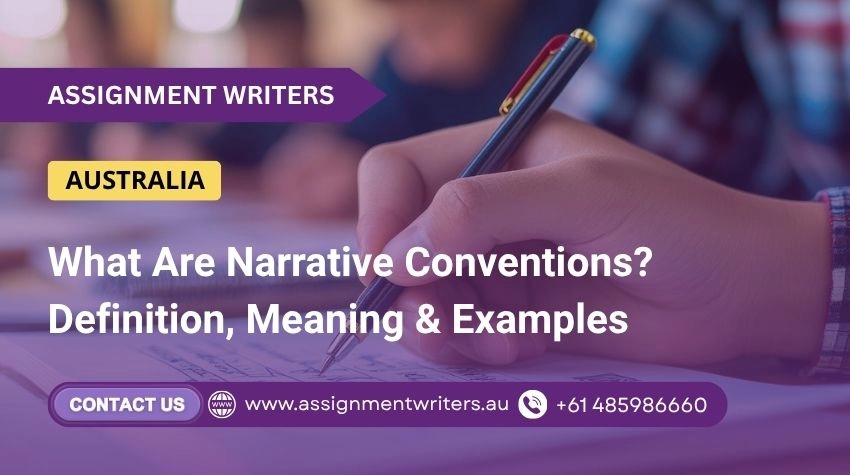A part of the English literature, Narrative Conventions offer a lot more than you can expect through thoughts and ideas. Each one of us has a story to tell that is interesting, exciting, and thought-provoking. However, most of you don’t have the understanding of how to approach this. Hence, the idea remains dormant and eventually lost. And even from an academic point of view, it is necessary to express your creative thoughts. Thus, in this blog, we will get into the depths of the conventions of narrative without any fluff.
What Is A Narrative Convention?
Narrative convention is generally an accepted practice, structure, and element that storytellers use to tell a story. It includes recognisable patterns in plots, character types, settings, narrations, and ideas that help audiences understand and make meaning of the story. Many of the writers and narrators take the help of Assignment Writers, who possess an unparalleled understanding and knowledge of writing from scratch. This also provides immediate storytelling that allows experts to creatively give audiences cues about characters and events.
Mistakes To Avoid While Doing A Narrative Convention
Whether you are a beginner or a thorough professional, the possibility of committing a mistake is highly likely while creating a narrative conventions list. Hence, you have to avoid a bunch of them just to get your basics right. These include:
Sidelining The A, B, and C’s of Storytelling
A major issue to ignore is the fundamental elements of storytelling: explanation, rising action, climax, falling action, and resolution. Once again, if there is no clear structure to your narrative, it can feel confusing and incomplete. Therefore, many will not be able to bridge the gap between understanding and confusion, leading to an ineffective outcome.
Weak Characters
Good stories tend to connect with the audience because great characters run the show. However, if your characters are flat, badly motivated, and inconsistent, then the audience probably won't care about them. Ensure that every character has a purpose and makes sense within the narrative arc.
Messing Up The Plot
Overloading the readers can confuse and distract them from your real intention. Complex subplots and twists can look clever, but unless they are easily mixed into the whole of the story, they will be confusing rather than engaging. Thus, one of the narrative convention examples is to keep the main plot simple and make sure everything supports it.
Issues With Managing The Pace
There will be moments while writing a convention where the pace of the story will definitely matter. Dragging the narrative or being in a rush when not required will only highlight faultlines in your work. Therefore, the advice from the expert Assignment Writers is to create a balance while giving enough space for important scenes to develop. Also, trim down parts that don’t contribute to or advance the story.
Telling Instead of Showing
When you try to tell a narrative, it won’t have much effect. The best step is to show it, which makes it more impactful. Rather than describing the roller coaster of emotions a character is going through, think of using behaviours, dialogue, and sensory details to express. Experiencing a story through actions is often a more vivid and experiential experience for an audience than just hearing a story.
Lacking Editing & Feedback
Once you have completed the writing process, most of you may try to submit the work as it is. Don’t make this mistake! What you need to do is edit your convention and make suitable changes that add quality to your work. Moreover, taking tips or feedback from experts on how to improve your work will be crucial.
What Is The Significance of A Narrative Convention?
Each story that you connect with has some significant meaning. It would not be worth anything if there were no meaning, and the story is simply outlined. Therefore, to convey meaning and more, the significance of a narrative convention is essential. Among the many reasons are:
Making The Audience Engage & Understand With Story
Without stories, no human is going to engage with a piece of writing. The work needs to be filled with relevant characters, with an engaging storyline, and a premise that sets the stage. When the readers engage with a hero, a villain, and a dramatic storyline that takes them through a swing of emotions, they deem it a success. But understanding what are narrative conventions, the audience becomes engaged, immersed, and responds accordingly.
Provide A Framework For Writers & Storytellers
Conventions of narrative offer a useful structure for developing and organising stories. They can also be viewed as creative tools to structure a plot, develop character arcs, and control the pacing of the storyline. Whether you are developing a mystery, a romance, or a sci-fi epic, these arrangements can offer you a beginning point to build from. Thus, these are also a guide to generate ideas, manage complexity, and ensure clarity.
Meeting Expected Expectations
For a story to be deemed a success, it is essential to develop expectations within the audience and then meet them. Expectations are a human characteristic; once not met, they can lead to devastating results. However, it is paramount to generate them and meet them or sometimes exceed them. This fulfils a sense of satisfaction and gives deeper meaning to your work.
Contribute To Identifying Genre & Consistency
No matter what the genre is, be it horror, comedy, mystery, sci-fi, or anything else, each of these has different requirements to meet. With the help of these arrangements, you can take the expectations of each genre’s audience and use that to generate different characters, events, and plots alongside the common ones. Hence, they will encounter a sense of duality: regular genre feed coupled with mystery setups.
Assists In Critical Analysis & Interpretation
By understanding how arrangements operate, critics and students can unpack how stories create meaning, portray cultural values, or disrupt social conventions. By recognising a narrative convention, readers and viewers can be more reflective and will be drawn towards the storytelling section, rather than passive consumers.
Categories of Conventions of Narrative You Should Not Miss
Conventions are not inflexible. They are just divided into various media, genres, and cultural segments that make them look stringent. Each of the categories has its own connotation, resulting in a different form altogether.
Medium Differences
The way stories are being told depends on the medium through which it is broadcast.
Films: Make use of visual and audio materials to convey your part of the story. Protocols including cross-cutting, montage, flashbacks, voice-over narration, parallel editing, soundtrack cues, and montage are common.
Novels: More internal access to characters, more flexible manipulation of time, free internal monologue, shifts of perspective, and all these factors influence the aspects of a novel.
Theatre: Dialogue-centered, limited shifts, staged relies upon space, time/space constraining.
Comics: Use panel transitions, spatial layout, comparison or nearness, and visual symbolism.
Interactive & Digital Narratives: Branching structure, irregularity, hypertext, user agency, multiple endings, and branching timelines.
Genre Conventions
On the topic of genre, expectations are set accordingly. Recognising genre conventions helps audiences know what kind of story to expect. These include:
Mystery: Through clues, detective figures, revelation, twist, etc.
Romance: Meet-cute, love triangle, conflict or misunderstanding, resolution (happy ever after).
Science Fiction: Worldbuilding, speculative elements, a general quest, utopia or dystopia, tension.
Horror: Fear of the unknown, escalation, tension, countless jump scares, isolation, and a sense of eeriness.
Thriller: High stakes, time pressure, cliff hangers, multiple parallel threads converging.
Cultural/Historical Variations
Looking at the western storyline, it is mostly fixed. There is a hero element, which is sometimes pursued by an opposing force (villain) or vice versa, and the conflict is resolved, and hence the story is linear. But if you look at the Asian tradition of storytelling, it displays cyclical time, harmony, and gradual resolution, if any conflict arises.
Tips From Experts On How To Use A Narrative Convention
Writing Narrative Conventions has become difficult as the stories have become quite linear and well-written. The arcs, themes, and premises have been written in detail by many. However, experts of the Assignment Writers have done thorough research on this topic and will assist you with some tips to better your writing and resultant work.
Learn About The Conventions Deeply
As a writer, it is essential to first have an understanding of narrative protocols before trying to break them. Read stories in the genre you enjoy, and pay close attention to how stories generally develop plot, characters, setting, and narrators. The process will help you to get a better understanding of how to write the conventions of narrative.
Choose Only Relevant Conventions
Some stories are good on their own and may not even require a convention. If your story is character-driven, then the internal conflicts within the character can be expressed for better results. Here, you don’t have to force protocols. However, a horror-based story will require you to use fear of the unknown, tension, and jump scares for better results.
Initiate With Familiarity Then Surprise
Audiences connect with familiarity, but too much can lead to predictability. A strong narrative is a balance of something familiar to readers, which they can enjoy for a while, but also something that is new and interesting to engage them. You can use standard conventions early in the story to support their expectations, and later on, flip them for emotional impact.
Connect Subject & Style To Theme
These are more than simply technical devices; they can carry more than a meaning. As a writer, align your use of conventions with any intended emotional aspects of your narrative to create a more unified and effective story.
Understand The Expectations
Expectations are a feature of each segment of the convention that must be fulfilled for better results. If a reader is going through a mystery genre, they expect clues, revelations, twists, and more. So, if you are writing within a genre, it is essential to know what the audience expects. Meeting or skillfully skipping conventions will make your work a success.
Mix Conventions With Genres
Each of the genres has its own set of conventions that the audience would like to witness. However, you can make your task distinct by combining conventions that give rise to innovation. Similarly, creating dynamic and dramatic cuts will enhance your storytelling technique. Thus, try to break the traditional boundaries of conventions.
Conclusion
Narrative Conventions are the fundamental elements of storytelling that assist writers and engage audiences across genres, media, and cultural contexts. These are not strict rules but rather are flexible frameworks that assist the development of stories' plots, characters and themes. The aim is to create plots that are meaningful, relatable, and impactful in the process. Descriptions are more enjoyable, satisfying, and effective when both writers and audiences understand conventions of narrative. Whether it is the rising action of the plot, the inner conflict of a character, or the comparative eeriness of tension in a horror narrative.

